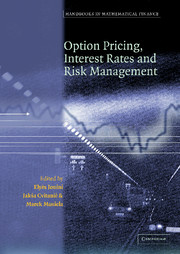Book contents
- Frontmatter
- Contents
- List of Contributors
- Introduction
- Part one Option Pricing: Theory and Practice
- 1 Arbitrage Theory
- 2 Market Models with Frictions: Arbitrage and Pricing Issues
- 3 American Options: Symmetry Properties
- 4 Purely Discontinuous Asset Price Processes
- 5 Latent Variable Models for Stochastic Discount Factors
- 6 Monte Carlo Methods for Security Pricing
- Part two Interest Rate Modeling
- Part three Risk Management and Hedging
- Part four Utility Maximization
6 - Monte Carlo Methods for Security Pricing
from Part one - Option Pricing: Theory and Practice
Published online by Cambridge University Press: 29 January 2010
- Frontmatter
- Contents
- List of Contributors
- Introduction
- Part one Option Pricing: Theory and Practice
- 1 Arbitrage Theory
- 2 Market Models with Frictions: Arbitrage and Pricing Issues
- 3 American Options: Symmetry Properties
- 4 Purely Discontinuous Asset Price Processes
- 5 Latent Variable Models for Stochastic Discount Factors
- 6 Monte Carlo Methods for Security Pricing
- Part two Interest Rate Modeling
- Part three Risk Management and Hedging
- Part four Utility Maximization
Summary
Introduction
In recent years the complexity of numerical computation in financial theory and practice has increased enormously, putting more demands on computational speed and efficiency. Numerical methods are used for a variety of purposes of finance. These include the valuation of securities, the estimation of their sensitivities, risk analysis, and stress testing of portfolios. The Monte Carlo method is a useful tool for many of these calculations, evidenced in part by the voluminous literature of successful applications. For a brief sampling, the reader is referred to the stochastic volatility applications in Duan (1995), Hull and White (1987), Johnson and Shanno (1987), and Scott (1987); the valuation of mortgage-backed securities in Schwartz and Torous (1989); the valuation of path-dependent options in Kemna and Vorst (1990); the portfolio optimization in Worzel et al. (1994); and the valuation of interest-rate derivative claims in Carverhill and Pang (1995). In this paper we focus on recent methodological developments. We review the Monte Carlo approach and describe some recent applications in the finance area.
In modern finance, the prices of the basic securities and the underlying state variables are often modelled as continuous-time stochastic processes. A derivative security, such as a call option, is a security whose payoff depends on one or more of the basic securities. Using the assumption of no arbitrage, financial economists have shown that the price of a generic derivative security can be expressed as the expected value of its discounted payouts.
- Type
- Chapter
- Information
- Handbooks in Mathematical FinanceOption Pricing, Interest Rates and Risk Management, pp. 185 - 238Publisher: Cambridge University PressPrint publication year: 2001
- 4
- Cited by



